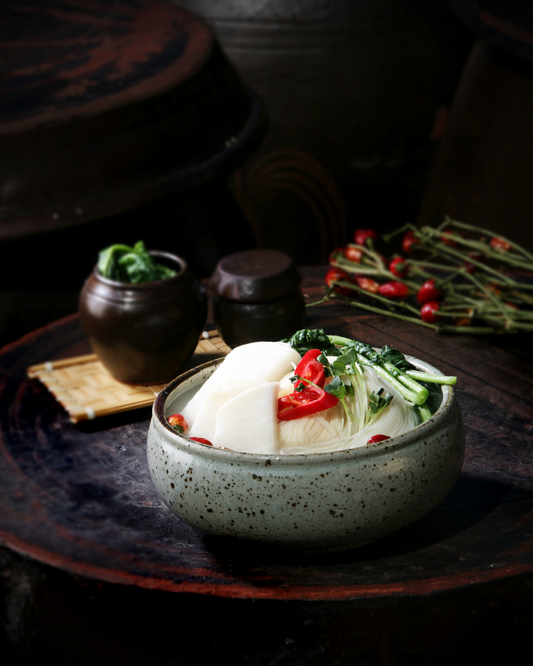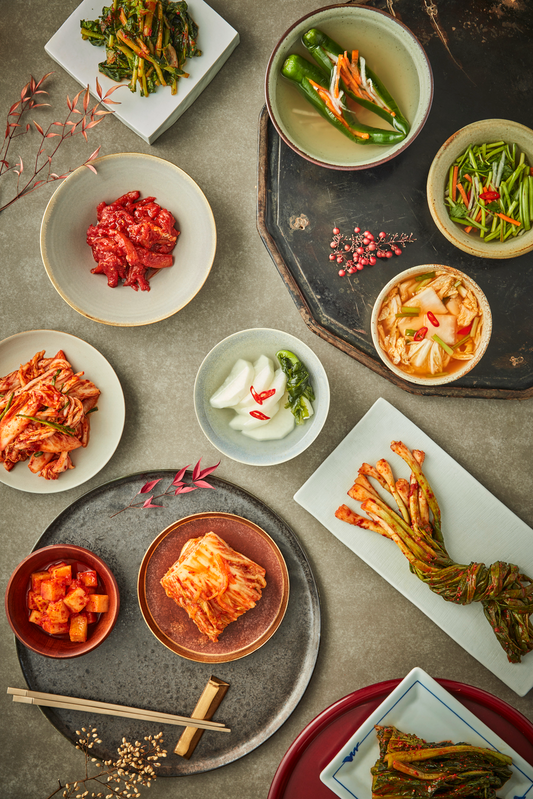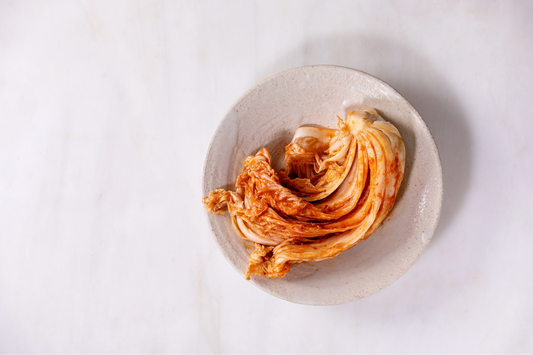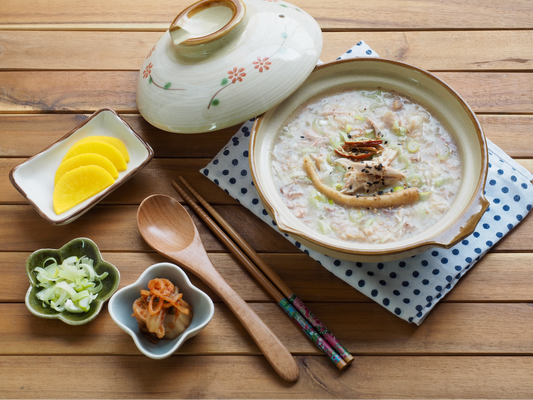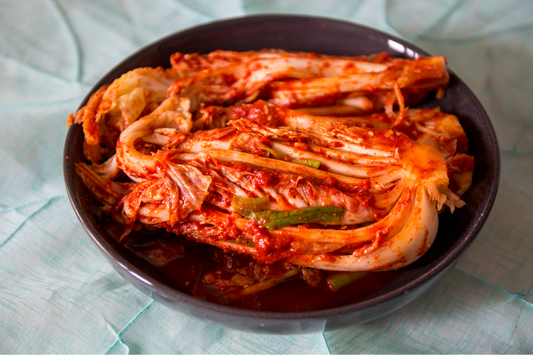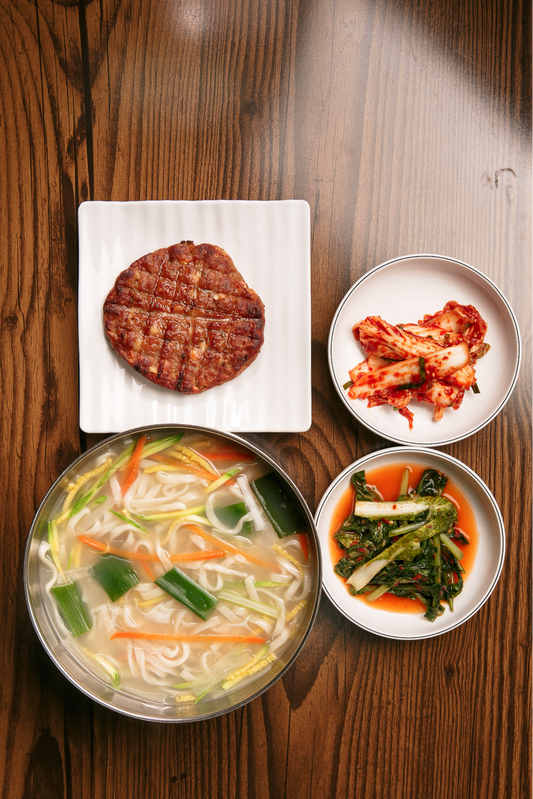Ever wondered how to spice up your meals? Green onion kimchi is the answer. This Korean dish is spicy and healthy. It's full of vitamins, minerals, and probiotics that boost your well-being.
Green onion kimchi, or daepa kimchi, is fermented green onions with a spicy paste. This process makes it taste great and healthy. A 1-cup serving has only 23 calories but is packed with nutrients like vitamin C and K.
Eating kimchi often can lower blood sugar and cholesterol. Its probiotics help prevent diseases like cancer and the common cold. Making it at home is easy. Just brine the onions, mix with paste, and ferment for a few days.
Key Takeaways:
- Green onion kimchi is a spicy, tangy, and savory Korean side dish made by fermenting green onions with a seasoning paste.
- Kimchi is low in calories but nutrient-dense, containing vitamins A, C, and K, as well as minerals like iron and calcium.
- The fermentation process creates beneficial probiotics that support gut health, boost immunity, and may help prevent various health conditions.
- Consuming kimchi regularly can decrease blood sugar, total cholesterol, and LDL cholesterol levels, and may even promote weight loss.
- Making green onion kimchi at home is a simple process that yields a delicious and healthy addition to your meals.

Definition of Green Onion Kimchi
Green onion kimchi, also known as daepa kimchi, is a traditional Korean dish. It highlights the unique taste and texture of green onions. This tangy and spicy side dish is a favorite among many kimchi recipes in Korean cuisine.
Basic description of Green Onion Kimchi
To make this tasty banchan, green onions are first salted to remove excess water. Then, they are mixed with a savory and spicy seasoning paste. The paste includes gochugaru, garlic, ginger, and fish sauce, creating a complex flavor.
After coating the green onions with the seasoning, the mixture ferments at room temperature for days. This process allows the flavors to meld and become more intense.
Differences between Green Onion Kimchi and other types of kimchi
While Napa cabbage kimchi is well-known, green onion kimchi is unique. It focuses on the mild, slightly sweet flavor of green onions. This ingredient balances the heat and pungency of the seasoning paste.
With over 200 different types of kimchi, green onion kimchi is a favorite among kimchi lovers.
Cultural background and characteristics of Green Onion Kimchi in Korean cuisine
In Korean culinary tradition, green onion kimchi is a staple side dish. It's perfect with rice, soups, stews, and grilled meats. During kimjang, families make large batches of kimchi, including green onion kimchi.
This tradition ensures a supply of flavorful kimchi in winter. It also strengthens family bonds and shares cultural heritage.

Ingredients and Benefits
Green onion kimchi is a nutritious and flavorful dish. It offers many health benefits. The main ingredients, green onions and gochugaru, work together with fermentation. This creates a probiotic-rich food that supports overall well-being.
Green Onion Health Benefits
Green onions are the star of this kimchi variety. They are packed with essential vitamins and minerals. They are a great source of vitamins A, C, and K.
These vitamins support eye health, immune function, and bone health. Green onions also contain antioxidants. These antioxidants help protect cells from damage caused by free radicals.
Additionally, the dietary fiber in green onions aids digestion. It may also help lower cholesterol levels. This promotes heart health.
The Power of Gochugaru
Gochugaru, the Korean red chili pepper flakes, add more than just heat. These flakes contain capsaicin, a compound with anti-inflammatory properties. Capsaicin may help reduce inflammation in the body.
Some studies suggest that capsaicin may also boost metabolism. This can aid in weight management efforts.
Probiotic Benefits
The fermentation process in green onion kimchi produces beneficial probiotic bacteria. These probiotics, such as Lactobacillus plantarum, improve gut health. They promote the growth of healthy bacteria in the digestive tract.
A well-balanced gut microbiome enhances nutrient absorption and supports the immune system. Research shows that consuming probiotic-rich foods like kimchi may help alleviate digestive issues. These include constipation and bloating.
By combining the health benefits of green onions, gochugaru, and probiotics, green onion kimchi offers a delicious way to support overall health and well-being. Incorporating this nutritious dish into your diet can help you enjoy the many advantages of its ingredients. You'll also savor its unique and spicy flavor profile.

Recipe
Making green onion kimchi at home is easy and rewarding. It lets you enjoy the spicy, tangy flavors of this Korean side dish. With a few ingredients and patience, you can make a delicious batch to enjoy with meals.
List of ingredients
To make green onion kimchi, you need:
- 2 pounds of green onions, washed and cut into 2-inch pieces
- 1/2 cup Korean solar sea salt (or other natural sea salt)
- 1/2 cup gochugaru (Korean red chili pepper flakes)
- 1/4 cup fish sauce
- 1/4 cup minced garlic
- 2 tablespoons minced ginger
- 1 tablespoon sugar
- Water for brining
Cooking process
Start by placing green onions in a large bowl. Sprinkle with Korean solar sea salt and mix well. Let them sit for about 30 minutes to release water. This step, called brining, softens the onions and removes bitterness.
Rinse the onions well and drain them. In another bowl, mix gochugaru, fish sauce, garlic, ginger, and sugar. This mix gives the kimchi its spicy and savory flavors.
Add the seasoning paste to the onions and mix until coated. Pack the mixture into a sterilized glass jar, pressing out air pockets. Cover loosely and ferment at room temperature for 2-3 days. This process develops the kimchi's flavors and tanginess.
Storage method
After fermentation, move the jar to the fridge to slow down fermentation. This keeps the flavor and texture of the kimchi fresh for longer.
Green onion kimchi can last up to 1 month in the fridge. But it's best eaten within 2 weeks for the best taste and texture. Always use clean utensils and seal the jar tightly between servings to keep it fresh.
Homemade green onion kimchi adds a spicy kick and tangy flavor to any meal. Enjoy it as a side dish, on rice or noodles, or in your favorite recipes for extra flavor.

Tips + Cooking Ideas
Green onion kimchi is super versatile. You can enjoy it as a side dish or add it to Korean recipes. It brings a tasty kick to your meals. Try making kimchi pancakes by mixing chopped kimchi into a batter and frying until golden.
Kimchi fried rice is another favorite. It combines leftover rice, veggies, and sometimes meat with kimchi's tangy, spicy flavors. This makes for a satisfying and comforting meal.
Various dishes and uses of Green Onion Kimchi
Green onion kimchi is great in many Korean dishes. For a hearty meal, try kimchi stew with kimchi, pork, tofu, and veggies in a spicy broth. It's also great on noodles, stir-fries, or grilled meats, adding flavor to any dish.
Don't be afraid to experiment with green onion kimchi in your recipes. Its bold taste and versatility will impress everyone!
Recommendations for foods that pair well with Green Onion Kimchi
Green onion kimchi pairs well with many foods. It's perfect with rich, fatty meats like Korean BBQ. Its acidity and spiciness balance the meat's heaviness.
It also goes well with starchy foods like rice, noodles, and potatoes. For a lighter meal, serve it with grilled fish or tofu. The green onions' sweetness complements these proteins nicely.
Lastly, green onion kimchi is great in banchan (side dishes) with Korean meals. It adds flavor and health benefits to every bite.
FAQ
What is green onion kimchi?
Green onion kimchi, also known as daepa kimchi, is a Korean dish. It's made with green onions, salted and mixed with a spicy paste. After a few days, it develops a tangy, spicy flavor.
How is green onion kimchi different from other types of kimchi?
Unlike most kimchi, which uses Napa cabbage, green onion kimchi focuses on green onions. This gives it a unique taste and texture compared to other kimchi types.
What are the health benefits of green onion kimchi?
Green onion kimchi is full of vitamins A, C, and K, and minerals like iron and calcium. The fermentation process adds probiotics, which are good for your gut and immune system. The spicy paste also has anti-inflammatory properties and may help boost metabolism.
What ingredients do I need to make green onion kimchi?
You'll need green onions, Korean solar sea salt, gochugaru, fish sauce, garlic, ginger, sugar, and water for brining.
How long does it take to make green onion kimchi?
Making green onion kimchi takes about 30 minutes to brine the onions. Then, mix them with the seasoning paste and let it ferment at room temperature for 2-3 days.
How should I store green onion kimchi?
After it's fermented to your liking, move the jar to the fridge. It can last up to a month in the fridge. But it's best eaten within two weeks for the best taste and texture.
What dishes can I make with green onion kimchi?
Enjoy green onion kimchi as a side dish or add it to Korean recipes like kimchi pancakes, kimchi fried rice, and kimchi stew. It's also great as a topping for noodles, stir-fries, or grilled meats.
What foods pair well with green onion kimchi?
It goes well with fatty meats like Korean BBQ and starchy foods like rice, noodles, and potatoes. It also pairs well with grilled fish or tofu. Plus, it's a great addition to a spread of banchan served with Korean meals.

